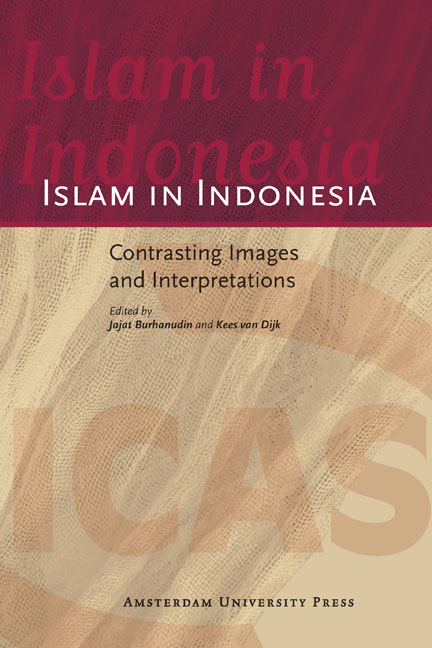Book contents
- Frontmatter
- Contents
- Introduction
- 1 Comparing Different streams of Islam: Wrestling with Words and Definitions
- 2 Defining Indonesian Islam: An Examination of the Construction of the National Islamic Identity of Traditionalist and Modernist Muslims
- 3 Indonesia in the Global Scheme of Islamic Things: Sustaining the Virtuous Circle of Education, Associations and Democracy
- 4 Distinguishing Indonesian Islam: Some Lessons to Learn
- 5 Islam, State and Society in Democratising Indonesia: A Historical Reflection
- 6 The Politics of Piety in the Pondok Pesantren Khusus Waria Al-Fattah Senin-Kamis Yogyakarta: Negotiating the Islamic Religious Embodiment
- 7 The Indonesian Muslim Feminist Reinterpretation of Inheritance
- 8 Managing Familial Issues: Unique Features of Legal Reform in Indonesia
- 9 A new Generation of Feminists within Traditional Islam: An Indonesian Exception
- 10 Religious Pluralism and Contested Religious Authority in Contemporary Indonesian Islam: A. Mustofa Bisri and Emha Ainun Nadjib
- 11 Islam and Humanitarian Affairs: The Middle Class and New Patterns of Social Activism
- 12 Dakwah radio in Surakarta: A Contest for Islamic Identity
- 13 Muslim Fundamentalism in Educational Institutions: A Case Study of Rohani Islam in High Schools in Cirebon
- 14 Majlis Tafsir Al-Qur’an and its Struggle for Islamic Reformism
- Glossary
- About the Editors and Contributors
- Bibliography
- Index
- Monographs
7 - The Indonesian Muslim Feminist Reinterpretation of Inheritance
Published online by Cambridge University Press: 09 January 2021
- Frontmatter
- Contents
- Introduction
- 1 Comparing Different streams of Islam: Wrestling with Words and Definitions
- 2 Defining Indonesian Islam: An Examination of the Construction of the National Islamic Identity of Traditionalist and Modernist Muslims
- 3 Indonesia in the Global Scheme of Islamic Things: Sustaining the Virtuous Circle of Education, Associations and Democracy
- 4 Distinguishing Indonesian Islam: Some Lessons to Learn
- 5 Islam, State and Society in Democratising Indonesia: A Historical Reflection
- 6 The Politics of Piety in the Pondok Pesantren Khusus Waria Al-Fattah Senin-Kamis Yogyakarta: Negotiating the Islamic Religious Embodiment
- 7 The Indonesian Muslim Feminist Reinterpretation of Inheritance
- 8 Managing Familial Issues: Unique Features of Legal Reform in Indonesia
- 9 A new Generation of Feminists within Traditional Islam: An Indonesian Exception
- 10 Religious Pluralism and Contested Religious Authority in Contemporary Indonesian Islam: A. Mustofa Bisri and Emha Ainun Nadjib
- 11 Islam and Humanitarian Affairs: The Middle Class and New Patterns of Social Activism
- 12 Dakwah radio in Surakarta: A Contest for Islamic Identity
- 13 Muslim Fundamentalism in Educational Institutions: A Case Study of Rohani Islam in High Schools in Cirebon
- 14 Majlis Tafsir Al-Qur’an and its Struggle for Islamic Reformism
- Glossary
- About the Editors and Contributors
- Bibliography
- Index
- Monographs
Summary
Introduction
Indonesia has a population of about 250 million people, 87 per cent of whom are Muslims. This means that the largest Muslim population in the world lives in Indonesia. In spite of this, the study of Islam has largely focused on the Middle East, seeing Islam in other parts of the world, such as Indonesia, as marginal or peripheral, and ‘syncretistic’ rather than ‘pure’.
Certainly, Islam in Indonesia is different from that in the Middle East. According to Azra (1994), it is colourful and peaceful, but not necessarily marginal. It is colourful because it has adapted to the various Indonesian cultures. The peaceful nature of Indonesian Islam may be due to the way Islam was introduced into the country. With respect to the time Islam arrived in Indonesia, there are two different opinions. One dates it back to the seventh century, soon after the birth of Islam in Arabia. This version assigns a crucial role to Arab traders in its dissemination. The other version is that Islam was brought to Indonesia in the thirteenth century by traders from Gujarat in India. Azra argues that Islam may have first been brought to Indonesia by traders from the Middle East, but that in the twelfth and thirteenth centuries, Islam was spread by Sufi teachers from the Middle East, who concentrated on teaching Islam. Consequently, the influence of Islam in the Indonesian archipelago became much greater after the twelfth century.
At the time that Sufi teachers were proselytising in Indonesia, Islamic civilisation had already started to decline in the Middle East. The production of knowledge, including the reinterpretation of Qur’anic texts, began to stagnate. Many of the contemporary Muslim scholars mainly summarised, commented on or explained the works of previous scholars. In addition, many Muslims had turned to Sufism. As a result, the nature of the Islam disseminated in Indonesia was sufistic. However, according to Azra (1994), the nature of the Sufism adhered to was in harmony with shari’a – that is, the Sufism practised was based on shari’a and was oriented towards the construction of a socio-ethical Muslim society, not merely towards individuals.
The way in which Islam was propagated in Indonesia also influenced the nature of Indonesian Islam. The process was peaceful rather than forceful or bloody.
- Type
- Chapter
- Information
- Islam in IndonesiaContrasting Images and Interpretations, pp. 109 - 122Publisher: Amsterdam University PressPrint publication year: 2013



